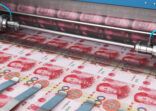After the sharp dislocation to risk asset prices in March, high yield credit spreads narrowed in the US and Europe. However, Asia high yield has lagged, and spreads are almost still as wide as they were during the worst of the global financial crisis 12 years ago, according to Hayden Briscoe, head of fixed income, Asia-Pacific, at UBS Asset Management.
The key factor is the behaviour of central banks, with the US Federal Reserve and the ECB including so-called “fallen angels” (that is, bond issues downgraded by rating agencies to junk status), as well investment grade corporate bonds, in their asset purchase programmes. In contrast, Asian central banks have confined their buying to local currency debt.
“Spreads haven’t compressed as much as US and European high yield, because Asian central banks have not been buying hard currency bonds as part of their market liquidity measures,” Briscoe said during a media briefing on Tuesday.
As a result, yields in the sector are as high as 10% and the spread differential over the energy-intensive US corporate high yield sector is as much as 300 basis points.
Yet, the Asian high yield market has little exposure either to commodities or the consumer cyclical sector, so it is less vulnerable than US high yield to this year’s slump in economic activity or to future negative surprises, according to Briscoe.
Instead, it is dominated by China property companies, and the “leading developers will benefit from demand from a rising domestic middle class and continued urbanisation, a recovery in prices and hence an increase in profitability,” he said.
Moreover, average duration is shorter than US and European high yield, so Asian bonds are less vulnerable to interest rate risk. In addition, default rates among China high yield issuers are only expected to reach 3%, which is lower than the US and Europe.
Asia high yield fund
Briscoe is a co-manager of the $1.64bn UBS Bond (Sicav) Asian High Yield Fund, which has generated a 10.31% cumulative return over the past three years, slightly less than its benchmark JP Morgan Asia Credit Non-Investment Grade index (11.43%), but better than its category average (8.53%), according to FE Fundinfo data.
“There is a very wide dispersion of returns among Asian high yield funds, and in these volatile times active management is especially important,” said Briscoe.
The fund has annualised volatility 8.91% over the same period, which is less than its peers (9.10%) and has earned alpha of 0.75, according to FE Fundinfo.
Reflecting the composition of the Asian high yield markets, the fund’s biggest country exposure by far is to China (56.7%), and property is its main sector allocation (45%), according to the most recent factsheet. However, two of its largest individual holdings are China Government Bonds (CGB), denominated in renminbi.
Other fund houses, including JP Morgan Asset Management and Blackrock, are also keen on onshore China fixed income.
UBS GAM plans to launch new Asia and China bond funds, including products with share classes available in different currencies.
“We are seeing strong demand from institutional investors for CGBs and among private bank clients for fixed maturity products comprising Asian high yield,” said Briscoe.
UBS Bond (Sicav) Asian High Yield fund vs JP Morgan Asian Credit Non-Investment Grade Index and sector average


















